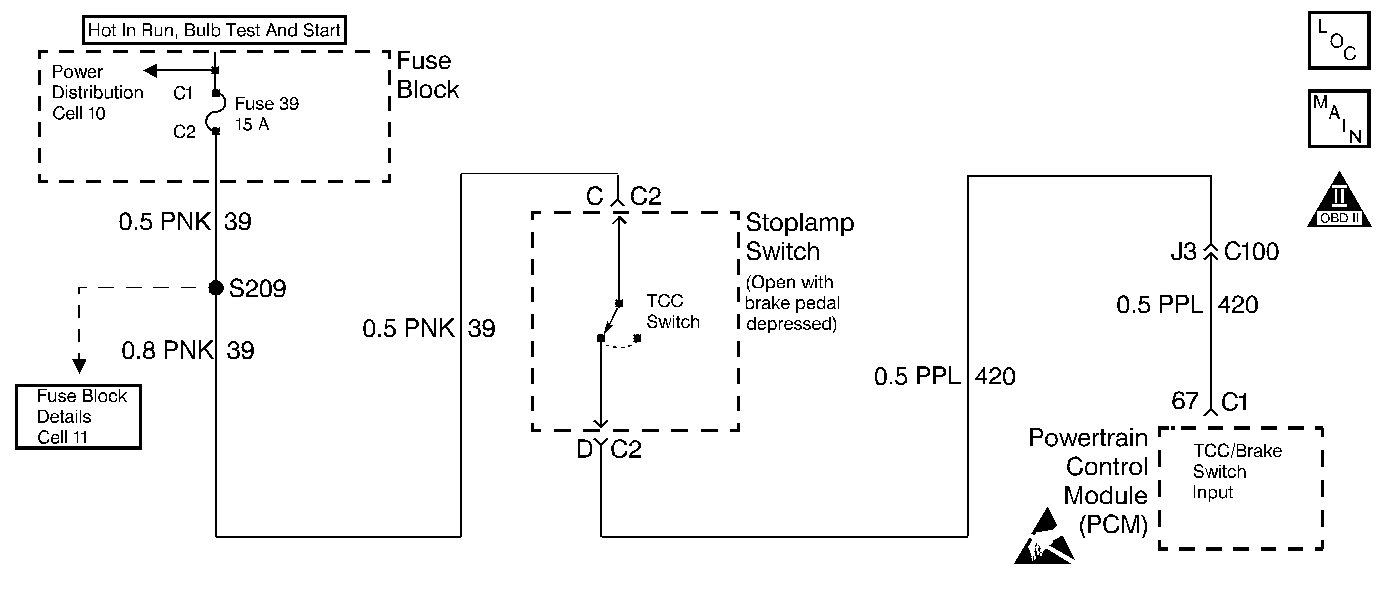
Circuit Description
The Torque Converter Clutch (TCC) brake switch reports brake pedal status to the Powertrain Control Module (PCM). The brake switch indicates that the brake pedal is either applied or released. The normally-closed switch supplies battery voltage on circuit 420 to the PCM. Applying the brake pedal opens the brake switch, interrupting voltage to the PCM. When the PCM receives 0 volts at the brake switch input, the PCM turns OFF the TCC Solenoid Valve.
If the PCM detects an open brake switch (stuck ON) during acceleration, then DTC P0719 sets. DTC P0719 is a type D DTC.
Conditions for Setting the DTC
| • | No VSS DTCs P0502 or P0503. |
| • | The vehicle speed is less than 8 km/h (5 mph). |
| • | Accelerate the vehicle to 32 km/h (20 mph) for 4 seconds. |
| • | The vehicle speed remains above 32 km/h (20 mph) for 6 seconds. |
| • | The above conditions must occur 7 times with the brake switch ON for more than 15 minutes, and the PCM receiving no voltage input for 2 seconds. |
Action Taken When the DTC Sets
| • | The PCM does not illuminate the Malfunction Indicator Lamp (MIL). |
| • | Disregard the brake switch for TCC scheduling when all of the following conditions are met: |
| - | The throttle position is greater than 6%. |
| - | The vehicle speed is greater than 70 km/h (44 mph). |
| - | The throttle position was previously greater than 12% while the vehicle speed was greater than 75 km/h (47 mph). |
| - | The brake switch has not been OFF for more than 2 seconds this ignition cycle. |
Conditions for Clearing the DTC
| • | A scan tool can clear the DTC from the PCM history. The PCM clears the DTC from the PCM history if the vehicle completes 40 warm-up cycles without a failure reported. |
| • | The PCM cancels the DTC default actions when the fault no longer exists and the ignition is OFF long enough in order to power down the PCM. |
Diagnostic Aids
| • | Inspect the wiring for poor electrical connections at the PCM. Inspect the wiring for poor electrical connections at the transmission 20-way connector. Look for the following problems: |
| - | A bent terminal |
| - | A backed out terminal |
| - | A damaged terminal |
| - | Poor terminal tension |
| - | A chafed wire |
| - | A broken wire inside the insulation |
| • | When diagnosing for an intermittent short or open, massage the wiring harness while watching the test equipment for a change. |
Test Description
The numbers below refer to the step numbers on the diagnostic table.
-
If DTCs P1651 and P1652 are also set, then the CLG FN/TCC fuse is open.
-
This step isolates the fault between the TCC Brake Switch and the harness.
Step | Action | Value(s) | Yes | No | ||||
|---|---|---|---|---|---|---|---|---|
1 | Was the Powertrain On-Board Diagnostic (OBD) System Check performed? | -- | ||||||
Important: Before clearing the DTCs, use the scan tool in order to record the Failure Records for reference. The Clear Info function will erase the data. Are DTCs P1651 and P1652 also set? | -- | |||||||
3 | Inspect fuse 39 for an open. Did you find and correct a problem? | -- | -- | |||||
4 |
Refer to Troubleshooting Procedures, Section 8. Did you find and correct a problem? | -- | -- | |||||
Does the brake status change from Applied to Released? | -- | |||||||
6 | Replace the TCC brake switch. Refer to Brake Switch Replacement, Section 5. Is the replacement complete? | -- | -- | |||||
7 |
Refer to Troubleshooting Procedures, Section 8. Did you find and correct a problem? | -- | ||||||
8 | Replace the PCM. Refer to Powertrain Control Module Replacement/Programming , Section 6. Is the replacement complete? | -- | -- | |||||
9 | In order to verify your repair, perform the following procedure:
Has the test run and passed? | -- | System OK |
